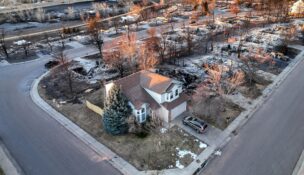Who owns Colorado: Holly after the storm
David Lewis //July 15, 2009//
Holly, Colo., seems to be going through a long, uncanny bad spell.
Holly seemingly has always acted as a magnet for trouble, attracting some of the worst kinds of misfortune in the economic, demographic and acts-of-God categories.
Greatness has brushed by Holly, then moved on. In 1541, the explorer Coronado marched over the site of today’s Holly Public Library, according to the Holly Historical Society. In 1806 Zebulon Pike, too, briefly explored what became Holly. Former Gov. Roy Romer, today chairman of the nonprofit Strong American Schools, grew up in the town but moved on and up.
Holly’s economic and demographic troubles seem rooted in the land. In southeast Colorado by the Kansas border, the town suffers from the secular decline of ranching and farming. In the past two decades, the farm and ranch depression halved Holly’s population from about 1,600 to the current 800.

Today’s economic and real estate fizzles aren’t helping: Westminster-based Tri-State Generation and Transmission Association in mid-June shocked Holly by putting off plans for a nearby coal-fired power generation plant.
“That was kind of depressing to us because we were expecting a little bit of a boom,” said Kammie Cathcart, president of the city’s branch of Colorado East Bank & Trust.
Holly also has been cruelly tested by catastrophes coming out of the sky. Perhaps it is noteworthy that the Holly Historical Society divides its website pages into categories including “Dust Bowl,” “Floods” (five major floods, from 1904 to 1965), “Blizzard,” “Tornado” and the Towner Bus Tragedy of 1931.
In 2006 and 2007, Holly answered the perennial existential question, “Can things possibly get worse?” by following a freak four-day blizzard with a freak half-hour tornado that grew stronger as it tore north through town, reaching wind speeds of up to 199 miles per hour, obliterating a path 600 feet wide.
“Holly had literally just finished putting the blizzard behind us when the tornado hit,” says town administrator Marsha Willhite. The Holly Tornado killed two, injured many and destroyed or seriously damaged more than 160 homes.
Today, many say the town has healed, or at least turned the most difficult pages of these sad chapters.
One sign of recovery was the recent closure of the Holly Recovery Task Force, which for two years had helped with distributing donations, aiding rent and mortgage payments, and gathering volunteers for home repair and rebuilding.

Task force member Cathcart recalls that she “jumped in as banker,” using her business acumen to help organize because, “people didn’t know where to start. … For a while after the disaster it was just chaos. We kept food and water in our lobby. We were the phone contact for people during the tornado because the bank wasn’t hit, thank goodness.”
Cathcart recalls a church in Tennessee that donated a semi-trailer full of neatly packed clothes, how much work it took to unpack it all, and how surrounding communities pitched in, too.
“It was so overwhelming. That’s all we did, was just take care of each other. Last August (2008) I finally felt like I got my breath back.” Grants and loans from the Small Business Administration and the Rural Farm Administration helped, and so did Colorado East Bank & Trust, which offered homeowners 30-year fixed loans 1.75 percent below then-prevailing rates.
Measured by Gross National Happiness and not Gross Domestic Product, observers would find Holly’s community spirit to be among the highest anywhere. As it is, the town’s real estate market continues to be battered by the Holly Tornado.
The Holly real estate market has shriveled from its pre-tornado proportions. The undisputed queen of Holly real estate, Barbara Rushton, says that, “It’s a little tougher to get listings. Before the tornado I would have 15 listings in Holly,” compared to five or six listings now.
“The tornado destroyed so many of the homes, and we have a housing shortage. No one is selling, they don’t move out, and new housing is all replacements for houses that were damaged or lost in the tornado,” Rushton says.
Holly is a town made up of not-high-value homes, says broker Gene Cruikshank, president of Lamar-based Cruikshank Realty Inc. If you don’t make a sale it’s hardly worth driving the 70-mile round trip.
New-home building is simply a cost-prohibitive proposition, Rushton says. “Homes that were $85,000 or $100,000 that were lost in the tornado, it has taken people $200,000 or $250,000 to rebuild. To build a three-bedroom, two-bath, that’s probably going to run you
$100,000 to build. That’s cost prohibitive in Holly. That’s an upper-end home in Holly, Colorado.”
Rushton keeps herself in the Holly real estate game by shuttling to a brokerage in Syracuse, Kan., where she employs three agents. She recently started a store called Western Things. Also, she works part-time data entry and transcription jobs, tests animals in the dairy laboratory in Syracuse, and sells Western items at rodeos.
She would never leave Holly, however.
“We had too many families that lost every single thing they owned. It was a very, very emotional time,” Rushton says. “I’m so proud of our town I can’t tell you enough about it.”
Adds Cathcart: “So many people helped in so many ways. Everybody pitched in; everybody was a hero.”
{pagebreak:Page 1}



























